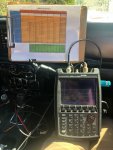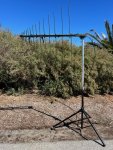prcguy
Member
I was going to add more to this package of information like a diagram of the setup, but I may never get to that so here its is as-is. I've been wanting to do an antenna range comparison of multi-band mobile antennas for some time and the recent purchase of a COMPACtenna LMR-1 compelled me to put this test together.
I've had most of the antennas tested for some time and all are in new or as new condition. mmckenna was kind enough to loan me a Larsen Tri-Band new version and an EM Wave Tri-band for this test. I also added a few dual band amateur and single band UHF gain types as I have always been curious about their performance and once everything is setup and calibrated its easy to test additional antennas.
The test vehicle was my Jeep Gladiator pickup with a trunk lip NMO mount on the front hood. Its all I had available and not everyone has the luxury of putting their mobile antennas on top of a large van roof anyway. The hood mount ground plane is not perfect and may have contributed some to the overall performance, but it should affect all antennas in a similar way on radiation pattern. VSWR, especially on VHF may not be ideal for some antennas tested and as mentioned, not everyone has a perfect ground plane available.
The test environment was on the So Cal coast with large hills blocking nearly all reception except out towards the ocean. The noise floor was very low and signal to noise ratio of my test signals were close to 60dB above the noise floor, which is extremely good. The test instrument was an Agilent FieldFox vector network analyzer in S21 mode feeding a broad band amplifier producing around 20dBm or a half watt. The exciter antenna was a Racal log periodic covering 100MHz to 1GHz continuous with about 6dBi gain placed off the front of the vehicle 35ft from the vehicle antennas under test and pointed at the test antennas. The test antenna mount had the entire length of the vehicle hood as a ground plane in line with the exciter antenna. The vehicle NMO mount had about 17ft of RG-58 coax terminated with a 6dB attenuator pad for matching to the test instrument.
The reference antennas were a 1/4 wave whip on each band with the VHF being a Sti-Co brand, the UHF being a Tram and the 800 being a Laird. These are simple 1/4 wave NMO whips tuned to roughly the center of each band and the FieldFox was calibrated with the band specific antenna on each band where the 0dB reference in the instrument became the normalized response of the 1/4 wave whip which the antennas under test were compared to. If the antenna under test showed + or - gain over the 0dB reference, that was the exact amount of gain that antenna had over a 1/4 wave whip.
Attached are the plots arranged by band, VHF 136-174MHz, UHF 400-500MHz and 800-950MHz. Also attached is a picture of the Racal log periodic exciter antenna and the test setup inside the test vehicle. After testing I discovered we made a mistake on the UHF and higher band limits which should have been 380-512MHz and 760-960MHz but we did get most of that.
You will notice some ripple in the measurements mostly on the higher bands. Depending on the antenna it could be a characteristic of the antenna or multipath in the test area or VSWR related. It is what it is and antennas in the real world on your car or mine will be different than calculated on paper. Some interesting conclusions from this test are the popular Larsen, EM Wave and Laird Tri-band antennas compared to the COMPACtenna Scan III and LMR-1 antennas. The VHF plots between these are within about 3dB favoring Larsen, EM Wave and Laird but on the UHF and 800 bands things reverse with the COMPACtennas looking very good. Its interesting to see an 11.5" long antenna even compete with others in the 16 to 19" length range and even outperform the others over some frequency ranges.
Another interesting test was using the VHF 1/4 wave reference antenna on the UHF band where it did surprisingly well at roughly 2dB down from the UHF reference 1/4 wave whip. I intended to test the VHF whip at 800MHz but got sidetracked and forgot. The Larsen dual band amateur performed about as expected as did the Maxrad and Motorola single band UHF gain types.
So, hopefully these plots will answer some questions about the different antennas tested like which one might work better here or there, or why does mine not do so well on certain bands. I don't think this should be taken as the end all answer of what antenna is best overall as a more comprehensive test using more vehicles and mounting locations would be needed. But these tests do point out some good and maybe not so good characteristics between the antennas tested.
Many thanks to teotwaki for the loan of the FieldFox VNA and assistance during testing and mmckenna for the antenna loan.


I've had most of the antennas tested for some time and all are in new or as new condition. mmckenna was kind enough to loan me a Larsen Tri-Band new version and an EM Wave Tri-band for this test. I also added a few dual band amateur and single band UHF gain types as I have always been curious about their performance and once everything is setup and calibrated its easy to test additional antennas.
The test vehicle was my Jeep Gladiator pickup with a trunk lip NMO mount on the front hood. Its all I had available and not everyone has the luxury of putting their mobile antennas on top of a large van roof anyway. The hood mount ground plane is not perfect and may have contributed some to the overall performance, but it should affect all antennas in a similar way on radiation pattern. VSWR, especially on VHF may not be ideal for some antennas tested and as mentioned, not everyone has a perfect ground plane available.
The test environment was on the So Cal coast with large hills blocking nearly all reception except out towards the ocean. The noise floor was very low and signal to noise ratio of my test signals were close to 60dB above the noise floor, which is extremely good. The test instrument was an Agilent FieldFox vector network analyzer in S21 mode feeding a broad band amplifier producing around 20dBm or a half watt. The exciter antenna was a Racal log periodic covering 100MHz to 1GHz continuous with about 6dBi gain placed off the front of the vehicle 35ft from the vehicle antennas under test and pointed at the test antennas. The test antenna mount had the entire length of the vehicle hood as a ground plane in line with the exciter antenna. The vehicle NMO mount had about 17ft of RG-58 coax terminated with a 6dB attenuator pad for matching to the test instrument.
The reference antennas were a 1/4 wave whip on each band with the VHF being a Sti-Co brand, the UHF being a Tram and the 800 being a Laird. These are simple 1/4 wave NMO whips tuned to roughly the center of each band and the FieldFox was calibrated with the band specific antenna on each band where the 0dB reference in the instrument became the normalized response of the 1/4 wave whip which the antennas under test were compared to. If the antenna under test showed + or - gain over the 0dB reference, that was the exact amount of gain that antenna had over a 1/4 wave whip.
Attached are the plots arranged by band, VHF 136-174MHz, UHF 400-500MHz and 800-950MHz. Also attached is a picture of the Racal log periodic exciter antenna and the test setup inside the test vehicle. After testing I discovered we made a mistake on the UHF and higher band limits which should have been 380-512MHz and 760-960MHz but we did get most of that.
You will notice some ripple in the measurements mostly on the higher bands. Depending on the antenna it could be a characteristic of the antenna or multipath in the test area or VSWR related. It is what it is and antennas in the real world on your car or mine will be different than calculated on paper. Some interesting conclusions from this test are the popular Larsen, EM Wave and Laird Tri-band antennas compared to the COMPACtenna Scan III and LMR-1 antennas. The VHF plots between these are within about 3dB favoring Larsen, EM Wave and Laird but on the UHF and 800 bands things reverse with the COMPACtennas looking very good. Its interesting to see an 11.5" long antenna even compete with others in the 16 to 19" length range and even outperform the others over some frequency ranges.
Another interesting test was using the VHF 1/4 wave reference antenna on the UHF band where it did surprisingly well at roughly 2dB down from the UHF reference 1/4 wave whip. I intended to test the VHF whip at 800MHz but got sidetracked and forgot. The Larsen dual band amateur performed about as expected as did the Maxrad and Motorola single band UHF gain types.
So, hopefully these plots will answer some questions about the different antennas tested like which one might work better here or there, or why does mine not do so well on certain bands. I don't think this should be taken as the end all answer of what antenna is best overall as a more comprehensive test using more vehicles and mounting locations would be needed. But these tests do point out some good and maybe not so good characteristics between the antennas tested.
Many thanks to teotwaki for the loan of the FieldFox VNA and assistance during testing and mmckenna for the antenna loan.





